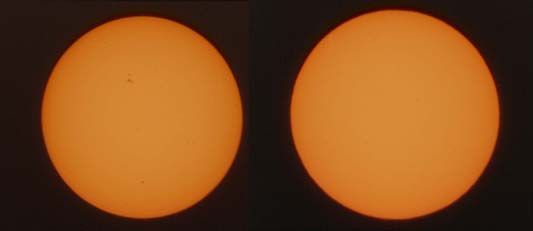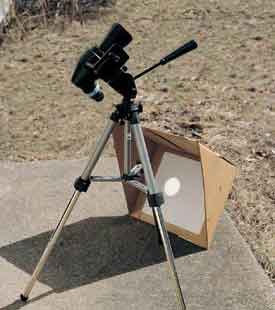From past the orbit of Mars, the solar system looks a bit like the above. Earth is just a speck, not even visible here (at the end of the blue line). The sun is much larger than the earth, yet still seems small and far away. Its light shines equally in all directions.
Can we actually verify this? Can we prove the sun is not actually a spotlight shining on only half of a flat earth, like some people claim to believe?
Yes, we can do this in various ways but I like practical science experiments that are (relatively) easy to perform, so I'm going to focus on a few here, things that you can do yourself. We shall demonstrate:
- The size of the sun is the sky remains almost exactly the same all day long, meaning the relative change in distance is very small, so it's very far away.
- The Sun looks circular from every direction, so the Sun is a sphere
- Over a single day sunspots remain in about the same position as the sun moves from horizon to horizon, so the Sun is very far away.
- Over the 26 days sunspots move over the surface of the sun in a spherical path, so the sun is a sphere.
Now the sun is incredibly bright so you can't just take a normal photo. You need to use a filter in front of the lens so you can block out most of the light. Still though you need a good zoom to be able to measure the size well (and to see sunspots, more on which later). But you can certainly do all of this with a camera if you have the right equipment.
A practical alternative is to use something most people will have access to - a pair of binoculars (or a telescope). Now it goes without saying you should never look at the sun though binoculars. Permanent eye damage could result. So instead of projecting an image of the sun permanently onto your retina you can instead project it onto a piece of paper.
This is a 2x4 piece of wood, about three feet long, attached to a tripod with cable ties (you don't need the tripod, it's just convenient). Each end of the 2x4 has some cardboard stapled to it. The top piece has a hole cut in it, aligned with one side of the binoculars, which are firmly fixed to the 2x4 with tape (and cable ties). You point it at the sun, and an image forms on a piece of white paper on the bottom card. You focus this image using the binoculars' focus knob.
This gives you a very safe and pretty high quality image of the sun. You can measure how big it is, and see if it changes through the day (it doesn't). You can also see if it implausibly changes shape (it remains circular)
For measuring the size, you can use some squared paper, as it gives a nice visual record.
Because the distance from the binoculars to the paper is fixed, then any change in the size of the sun would be reflected in the size of the projected image. No such changes were observed, and the sun stayed the same size and shape size from horizon to horizon.
We normally think of the sun as just a very bright light, but if you look closely you can see some detail in the surface of the sun - sunspots. We can observe how these move through the day, and see if they indicate the Sun is a sphere.
Now for reference, I recommend you get a recent image of the sun from the SDO, here's the one corresponding with today's images.
Just a couple of small spots, but enough to work with. I've got the SDO app on my phone, and used that as a reference. You can just make out the two spots in each image.
Now at first glance it might look like the spots are in the wrong place, but because we are projecting wth the binoculars rather than looking through them the image is inverted, it's upside down. Also the orientation of the SDO image isn't going to match the orientation of this image from Earth, as your latitude and the time of day will alter your viewing angle. So if we flip my image vertically and rotate it a bit you'll see that it lines up exactly. Drag the slider below to see this.
[compare]
So what happens to sunspots over the course of the day? Very little. They rotate based on the angle of the viewer, like the moon and the stars do (this is known as field rotation - you are rotating, so your field of view seems to rotate). They also move slightly to the right due to the rotation of the Sun. But basically the same side of the Sun is a facing you all day long, and since it's a sphere, and the same side is facing everywhere on the Earth, then that means it's a very large and far away sphere. Many times further away than the size of the Earth.
One thing we should be able to do after taking a few observations is to trust the SDO images match our images. This is what the sun looks like from everywhere in the world. It has been verified countless times because taking photos of sunspots is something people do hundreds of times a day, and something you can do yourself. But if you really want to, you can verify the following just by taking lots of photos for a couple of days.
Here's two days of photos of the sun, made into a time-lapse movie. It the 48 hours prior to the above SDO image which we verified:
Source: https://www.youtube.com/watch?v=AERs0LuANAQ
You'll notice that the sun is rotating from west to east, to the right. People often don't realize that the sun rotates. Viewed from Earth the Sun completes a full revolution every 26.24 days. So this two day period is about 1/13th of a full rotation (although with no fixed surface this does not have quite the same meaning as the rotation of a rock planet).
What is significant here is that we can see the rotation in the SDO images (and verify it with our own images). We can also see that this is the rotation of a sphere by observing sunspots (particularly larger ones in groups) and seeing that they move exactly as we would expect on a rotating sphere. You can see this somewhat with the sunspot on the right as it approaches the edge. However to really get a sense of the Sun's rotation (and roundness) have a look at a longer period, with more sunspots.
Source: https://www.youtube.com/watch?v=oInoNnPsxcA
Now you might argue this is "just an animation", but it's just a series of SDO images, images that are quite easily independently verified as I did above. This is verifiably what the sun looks like from everywhere on the globe, and verifiably how sunspots move around it.
One more thing we can do if we take photos of the sun with the same settings is compare them, and see they don't change though the day.
When there's some nice visible sunspots we can see how much the sun's image appears to rotate from my perspective (because of the rotation of the earth). Again, note the absolute lack of any change in size.
Hence we have demonstrated that the sun is a large distant rotating sphere, and by extension we have demonstrated yet again that the Earth is not flat.
Last edited:


